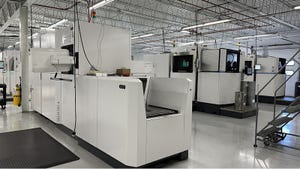November 30, 2010

Oneof the most common questions asked when setting up a new closed-loop motioncontrol system is, "What gains should be used for the control loop parameters?"One way to get to the answer is to contact the motion control company fortechnical support. However, the person asking for help may not realize theperson providing technical support cannot help without knowing importantdetails about the system being tuned. Because of this, designers often resortto determining the gains for the PID (proportional, integral and differential)components of the control loop equation using trial-and-error methods. This canbe very wasteful in both time and performance.
Fortunately,technologies are available for closed-loop tuning for applications that handleposition, speed and pressure or force control using models that are developedby analyzing the operation of existing systems. As a result, it is possible tocompute the gain, natural frequency and estimate a damping factor for awell-designed hydraulic system by measuring how the system responds tostimulus. Once the system model is known it is easy to calculate the controllergains and feed forwards that should be used. Even if the model is off by 10percent the controller gains that the model generates will provide a good,practical start that requires only minor adjustments.
Auto Tuning Explained
Autotuning software computes the coefficients for a system model by finding whatcoefficient values minimize the error between the actual response of a systemand the model's predicted response. Usually auto tuning software is written totune a particular type of system where the form of the model is already knownor assumed. In these cases, the software simply finds the coefficients for thatmodel. Therefore, if the system being tuned does not fit one of the modelspre-programmed into the auto tuning software, the software will not workcorrectly. For example, the operation of a process control system designed fortemperature control is usually assumed to be modeled by a first- orsecond-order differential equation plus dead time. This type of model is quitedifferent from a model for an under-damped hydraulic position control system.
Autotuning requires that the system be excited by varying the control output to thesystem. Some auto tuning systems simply use a step change in the control outputand some use pulses. The control signal must make some transitions betweendifferent levels and also provide time for the system's response to theexcitation to stabilize at the new level. The response of the system to thecontrol stimulus will provide information about the time constants of thesystem and the steady state conditions.
Autotuning systems differ in how much data is collected and how that data is used. Forexample, some motion control systems generate a pulse and record the maximumspeed reached by the motion axis and how long it takes for the axis to coastdown to zero speed. From this data, it is easy to calculate a time constantfrom the ramp down time and the gain(s) can be calculated by using axis speedand the pulse time compared to how fast the axis would have been going if itwere allowed to continue for 5 time constants. This method is easy but not veryrobust since it relies heavily on just a few readings and only supportsfirst-order models (i.e. models that can be expressed by linear equations).
Moresophisticated auto tuning systems can excite the system in a number of ways andthe excitation does not need to be a pulse or a step change. In these cases, adifference equation or differential equation is used to estimate the processusing the control output and assumed values in the equation that represent thesystem gain, offset and time constants. The first estimation is usually notvery good but there are software algorithms such as Levenberg-Marquardt andL-BFGS that can find values for the difference or differential equation thatminimize the sum of squared errors or the norm between the recorded processvariable and the estimated variable for each time period. After a hundrediterations or more, the best plant gain, offset and time constant are found forthat model only. At this point it is possible to repeat the process using adifferent model in an attempt to try to reduce the sum of square error betweenestimated and actual process variables.
Thegraph in Figure 1 shows how the Levenberg-Marquardt algorithm enables findingthe system model even when the feedback data is noisy or the system has lowresolution feedback. Auto tuning systems that rely on just a few points willprobably fail to calculate good gains in these high noise and low resolutionsystems. Auto tuning software that minimizes the error between the estimateddata from the model and the actual data from the feedback during every sampleperiod will provide much better gains.
Why Auto Tuning Doesn'tAlways Work
Themain reason an auto tuning software package would fail to deliver is when thatauto tuning software doesn't include a model that matches the real system underconsideration. To understand the differences between system models, considerdifferent system types:
Integrating and non-integratingsystems. Withintegrating systems, the process variable stays where it is when the controloutput stops as long as there isn't an outside disturbance. Position actuatorsor tank level control valves or pumps are examples of integrating systems. Aposition actuator will stop when it reaches a target position and a tank isobviously an integrator of net flow, which maintains its level when its targetlevel is reached.
Withnon-integrating systems, the process variable will settle back to an ambientstate. For instance, a temperature system will cool off or warm up to ambienttemperature when heating or cooling is not longer applied. A velocity controlsystem is also non-integrating because the moving axis will coast to a stopwhen the motive force is removed.
Anauto tuner that works for non-integrating processes will not work forintegrating processes and vice versa.
Dominant one- or two-pole systems. Many systems are simple and canbe approximated by single-pole or two-pole models that have time constants. Itis best if the auto tuning software can support both single and double polemodels, but the errors will probably not be big if the double pole model isn'tsupported. Using a FOPDT (first-order-plus-dead-time) model for a SOPDT(second-order-plus-dead-time) system may work if one of the time constants isshort compared to the other.
Non-linear systems. Modeling non-linear systems usinglinear models is virtually impossible. Even if these systems can be correctlymodeled by the auto tuning software, it is doubtful that the information willprove useful without extra programming in the controller to adjust the controlloop gains as a function of the process variable. As soon as custom programmingis employed, the model becomes application-specific and may not be applicableto other control situations. Therefore, many auto tuning systems don't supportnon-linear models and auto tuning programs support only one model. And if thesystem being tuned doesn't match one of the models, the auto tuning simply willnot work well or work at all.
Hydraulic SystemApplication
Anauto tuning paradox is that linear systems are usually easily tuned eithermanually or automatically. Therefore, the engineer can simplify the tuningprocess by designing the machinery to be as linear as possible. When this isnot possible, the system may be approximated by dividing the motion travel intolinear segments. The segments should be small enough so that the auto tuningsoftware can easily find a linear approximation for each segment.
Fora simple example of a system where using multiple gain segments can providebetter response, consider the dual-gain system referenced in Figures 2 and 3. Thehydraulic system being tuned contains a dual-gain valve. Dual-gain valves areuseful to provide responsive control over a wide range of velocities (lowergain when motion is slower, higher gain in order to respond quickly when theaxis is moving more quickly). Different gains may also apply to differentranges of position (consider what is required to move a linear hydraulic axisin an arcing profile).
Inthe valve referenced in Figures 2 and 3, the low gain portion of the valveresponds to voltage inputs between zero and approximately 4.47V where the low gaintranslates to moving the
hydraulic actuator at
about 1.07 inches per sec pervolt. The high gain section goes from 4.47 to 10V and the gain in this sectionis 7.61 inches per sec per volt. (Note that the valve manufacturer's specificationsdon't provide this information).
Inthe case of Figure 2, the auto tuning software was used to generate the gainsfor the two valve segments separately, and the profile of the actual versustarget axis velocities match very closely.
Theanalysis shown in Figure 3 uses the same auto tuning approach but without thedual gain model. The auto tuning software can only estimate an average gainover the whole range of control outputs. There are large errors between thismodel's estimated velocity and the actual velocity. If gain scheduling (i.e.,the use of different gains at different times) is not used, the gainscalculated from this model may be the best choice, but for higher performanceand precision systems the dual gain model will be much more accurate.
About the Author(s)
You May Also Like








